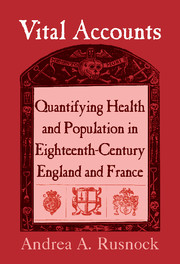Book contents
- Frontmatter
- Contents
- List of Illustrations
- Acknowledgments
- Vital Accounts
- Introduction
- 1 A New Science: Political Arithmetic
- PART ONE SMALLPOX INOCULATION AND MEDICAL ARITHMETIC
- 2 A Measure of Safety: English Debates over Inoculation in the 1720s
- 3 The Limits of Calculation: French Debates over Inoculation in the 1760s
- 4 Charitable Calculations: English Debates over the Inoculation of the Urban Poor, 1750–1800
- PART TWO MEDICAL ARITHMETIC AND ENVIRONMENTAL MEDICINE
- PART THREE POLITICAL ARITHMETIC
- Conclusion
- Bibliography
- Index
- Titles in the series
2 - A Measure of Safety: English Debates over Inoculation in the 1720s
Published online by Cambridge University Press: 15 October 2009
- Frontmatter
- Contents
- List of Illustrations
- Acknowledgments
- Vital Accounts
- Introduction
- 1 A New Science: Political Arithmetic
- PART ONE SMALLPOX INOCULATION AND MEDICAL ARITHMETIC
- 2 A Measure of Safety: English Debates over Inoculation in the 1720s
- 3 The Limits of Calculation: French Debates over Inoculation in the 1760s
- 4 Charitable Calculations: English Debates over the Inoculation of the Urban Poor, 1750–1800
- PART TWO MEDICAL ARITHMETIC AND ENVIRONMENTAL MEDICINE
- PART THREE POLITICAL ARITHMETIC
- Conclusion
- Bibliography
- Index
- Titles in the series
Summary
A Practice which brings the Mortality of the Small Pox from one in ten to one in a hundred, if it obtain'd universally would save to the City of London at least 1500 People Yearly; and the same Odds wou'd be a sufficient prudential Motive to any private Person to proceed upon.
[John Arbuthnot] 1722Just as the fear of plague led to the collection and publication of the London bills of mortality, which Graunt had so creatively used in his Natural and Political Observations, smallpox stimulated the development of medical arithmetic during the eighteenth century. Although smallpox had a significantly lower fatality rate than plague, its impact on public life was almost as great. Numerous members of the royalty succumbed to smallpox, including Queen Mary of England in 1694 and Louis XV of France in 1774. Smallpox caused disfigurement, blindness, and widespread suffering, which haunted the popular imagination. But it was not just the experience or fear of smallpox that led individuals to analyze its mortality rates. As with plague, the hope of preventive measures to offset the incidence of smallpox played an important role. Quarantine and fleeing potentially risky environments for safer climes were standard public health measures used to prevent or at least to limit plague epidemics. However, there existed a more potent preventive measure for smallpox: inoculation.
Inoculation provided an individual with a measure of safety – of immunity – against future smallpox epidemics.
- Type
- Chapter
- Information
- Vital AccountsQuantifying Health and Population in Eighteenth-Century England and France, pp. 43 - 70Publisher: Cambridge University PressPrint publication year: 2002



